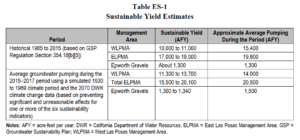Groundwater Sustainability Plan for the Las Posas Valley Basin
Dudek | December 13th, 2019
The Fox Canyon Groundwater Management Agency (FCGMA, or the Agency), has developed this Groundwater Sustainability Plan (GSP) for the Las Posas Valley Basin (LPVB; DWR Basin 4-008) in compliance with the 2014 Sustainable Groundwater Management Act (SGMA) (California Water Code, Section 10720 et seq.). FCGMA is one of three Groundwater Sustainability Agencies (GSAs) in the LPVB. The other two GSAs are the Camrosa Water District GSA–Las Posas Valley and the Las Posas Valley Outlying Areas GSA. This GSP is the sole GSP prepared for the LPVB, and covers the entire LPVB, including all areas of the LPVB outside of FCGMA’s jurisdiction. The purpose of this GSP is to define the conditions under which the groundwater resources of the entire LPVB, which support agricultural, municipal and industrial, and environmental uses, will be managed sustainably in the future.
Although the California Department of Water Resources (DWR) has defined the LPVB as a single groundwater basin, the western and eastern parts of the basin are hydraulically separated from each other by the Somis Fault, a geologic feature that inhibits groundwater flow across it. As a result, groundwater conditions on the west side of the fault in the Fox Canyon Aquifer and Grimes Canyon Aquifer, two primary aquifers in the LPVB, differ from conditions on the east side of the fault. Furthermore, the Epworth Gravels Aquifer, located on the east side of the fault is hydrologically separated from the Fox Canyon Aquifer and Grimes Canyon Aquifer. Hydrologic differences in the controls on, and responses to, both recharge and groundwater production necessitate the definition of three separate management areas in the LPVB. These three management areas are the West Las Posas Management Area (WLPMA), the East Las Posas Management Area (ELPMA), and the Epworth Gravels Management Area. The hydrologic conditions, sustainable yield, and sustainability criteria are discussed and defined by management area throughout this GSP.
Historical groundwater production in the LPVB has resulted in chronic declines in groundwater levels and loss of groundwater in storage in parts of each of the three management areas. In the WLPMA, the average rate of groundwater production between 2015 and 2017 was approximately 14,000 acre-feet per year (AFY). In the ELPMA and the Epworth Gravels Management Area, the average rate of groundwater production between 2015 and 2017 was approximately 20,500 AFY and 1,500 AFY, respectively. Numerical groundwater simulations indicate that if these production rates were carried into the future, groundwater elevations in each of the management areas of the LPVB would not recover during multi-year cycles of drought and recovery.
In order to determine the sustainable yield of each management area, combinations of projects and management actions were explored to estimate the rate of groundwater production that would prevent chronic declines in groundwater elevation and ongoing loss of groundwater storage in the future. Additionally, in the WLPMA, the numerical groundwater model simulations were used to assess the influence of groundwater conditions on the adjacent Oxnard Subbasin. In the ELPMA, numerical groundwater simulations were also used to assess zones of the Fox Canyon Aquifer that are most prone to conversion from confined to unconfined conditions. The rate of groundwater production that avoids chronic water level declines, loss of storage, potential land subsidence, and impacts to adjacent basins is referred to as the sustainable yield for each management area.
With the currently available projects and management actions, the sustainable yield of the WLPMA is approximately 12,500 AFY, with an uncertainty estimate of ±1,200 AFY (Table ES-1). In the ELPMA, the total sustainable yield (including the Epworth Gravels Management Area) is estimated to be 17,800 AFY ±2,300 AFY. For the Epworth Gravels Management Area only, the sustainable yield is estimated to be approximately 1,300 AFY. Except for the Epworth Gravels Management Area, both the historical (1985–2015) and recent (2015–2017) groundwater production rates exceeded the upper end of the future sustainable yield estimates (Table ES-1).

Adoption of this GSP represents the first step in achieving groundwater sustainability within the. LPVB, as required by SGMA. SGMA requires that groundwater in each of the management areas of the LPVB be managed sustainably within 20 years of adoption of the GSP. SGMA also requires that this GSP be evaluated at a minimum of every 5 years after adoption. As part of the 5-year evaluation process, the sustainable yield will be refined and adjusted. These refinements will be based on new data, additional studies undertaken to fill data gaps, and groundwater modeling.
Refinements and adjustments will also be made to the minimum threshold groundwater levels developed to avoid undesirable results, the measurable objective groundwater levels that account for the need to continue groundwater production during drought cycles and the associated interim milestones to help gauge progress toward sustainability over the next 20 years.
The required 5-year evaluations will also examine both new water supply projects, and the potential impacts of extractions rates on groundwater elevations and sustainability in the LPVB. Additional modeling is recommended during the 5-year update process to understand how changes in pumping and additional new water supply projects can increase the overall sustainable yield of the different management areas of the LPVB. As this understanding improves, projects to support increases in the overall sustainable yield can be developed.
Keywords
coastal aquifers, Groundwater Exchange, groundwater pumping impacts, Groundwater Sustainability Plan (GSP), seawater intrusion, Sustainable Groundwater Management Act (SGMA)